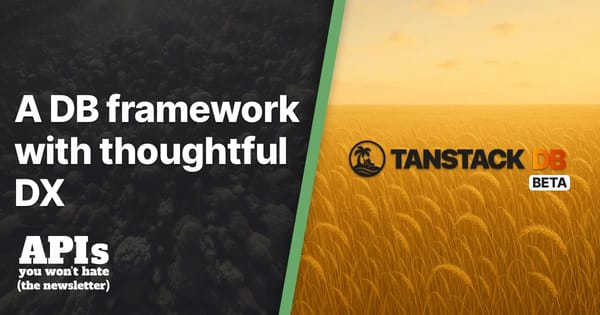API Design Reviews Don't Have to be Hard
A quick look at how you can handle API design reviews in pull requests using Bump.sh instead of forcing everyone to stare into a chasm of YAML diffs.

An API Design Review is one of a few parts of a larger API Governance program, where various people review changes to an API to make sure its a good choice for the architecture and wider ecosystem. This often involves a wide variety of persona, including API designers, API developers, technical writers, system architects, and maybe even a dedicated governance team.
Design reviews are generally done for an API overall when its first form is created, then with following iterations as new endpoints and other changes are made. Beyond the basic tire-kicking, a design review is important to ensure the API is well-designed, compliant with standards and style guides, meets the needs of its consumers, and does not introduce problems to the wider ecosystem.
What happens during a design review
- Consistency and Standards Compliance - Ensure the API follows established design standards and conventions, covering naming conventions, Hypermedia formats, authentication strategies, etc.
- Clarity - Verify that the API endpoints, parameters, and responses are clearly documented. Ensure descriptions are meaningful and useful for developers of both the API and its consumers.
- Functionality and Usability - Make sure the API endpoints provide the necessary functionality, evaluating the ease of use for developers integrating with the API.
- Performance and Scalability - Evaluate the API design for potential performance bottlenecks. Are consumers going to need to load 1,000 endpoints to solve the main use-case, or is data being computed on load which might slow things down?
- Backward Compatibility - Identify any breaking changes that could affect existing consumers of the API. Ensure that changes are backward compatible or properly versioned.
- Forwards Compatibility - Is this change going to work properly and fit in with future changes that are either planned to happen, or likely to happen within the wider ecosystem, to avoid conflicts or duplication.
- Security and Privacy - Check that authentication and authorization mechanisms are present and appropriate for the task at hand, and personal/private information is not being leaked by URL fiddling.
- Error Handling and Responses - Ensure that error responses are sensible, following the right standards, and are both meaningful and insightful for developers and potentially any end-users who end up seeing the error messages directly.
- Impact on Documentation - Determine how changes will affect existing documentation (reference docs, guiders, tutorials, etc). Ensure that documentation is updated to reflect any changes in the API before the change is made to avoid anything getting out of sync.
It seems like a whole lot to think about but that is why design reviews pull in multiple people from various departments or walks of life. Getting all these aspects nailed down during a design review means you can make sure the API is useful, well-documented, consistent and standards compliant, hopefully not riddled with security holes, and generally reduce the chances of problematic API changes getting into production.
Where do design reviews happen?
There are countless ways people try to handle this. One of the most complicated came from a famous API thought leader who suggested folks email Word documents full of feedback around with spreadsheets to track them...
A far more common approach is to put the review process through the same Pull Request workflow that developers are already using to review code changes on GitHub, GitLab, Azure Devops, etc.
To know the best way forward it's helpful to know the history of the pull request because it hasn't been around all that long. For decades developers would email around a diff file (short for difference) called new-function.diff and people would chat about that technical change on their IRC channels or around the water cooler.
It was a massive faff and multiple diffs could conflict, so when Git gained popularity and added the git-request-pull command, that eventually ended up in GitHub as a Pull Request and the whole code review process matured.
Reviews done right with Pull Requests
As the pull request matured it became the home for everything, allowing everyone can see a summary of changes, view source code if they want, see previews, comment on specific lines, suggest changes, and people could checkout the changes if they felt like playing around. All of these abilities gave far more people the option to interact with changes in their own preferred way, to see what is changing, and if it matters to them.
This is exactly how code changes should be managed, but API design reviews are not code reviews. The design review is more interested in the interface being built by the API than the source code on the inside, and forcing people to read code to work out what that might mean in terms of HTTP and JSON is not helpful.
Only the developers should be worrying about the code, the system architects, governance teams, and technical writers want to have a higher level view instead of having to learn every single teams' favourite web application frameworks conventions and syntax.
The role of API specifications
This is where API descriptions like OpenAPI and AsyncAPI come in. When stored together with the source code (and used for this like contract testing to ensure the code and description match perfectly) it means these discussions can be had around the YAML/JSON that describes the API instead of getting everyone pouring over the source code.
A huge step in the right direction, but reviewing hundreds of lines of YAML changes is not easy or fun. Some tooling has appeared trying to move the whole API design review process into a rough approximation of Git that's all trapped in their walled garden and requires constant syncing. Bump.sh instead focuses on allowing design reviews happen in the pull request, and we'll see how to handle that below.
Diffs Aren't Design Reviews
Technical writers often report difficulty staring directly into a pull request that's making loads of changes to massive OpenAPI documents.
A single pull request might involve anything from reordering some parameters, complete reorganization of the file structure of infinite $ref'ed YAML, to a breaking change that could the vast majority of integrations API consumers. It can all be lost in a sea of red and green changes in the "diff" view.
Technical writers shouldn’t need to learn YAML and stare into the void like this, nor should they need to use complex CLI tools or anything else just to see what has changed in an API. Nobody should need to do that.
Bump.sh helps simplify this process by analyzing OpenAPI documents and identifying meaningful changes so tech writers can focus on relevant updates without getting lost in unnecessary details.
Why Not All Changes Matter
Some changes in OpenAPI documents have no impact on API consumers, such as:
- Splitting larger documents into smaller pieces with
$ref. - Renaming referenced files.
- Renaming component names (e.g. renaming
components.schemas.Somethingwhich does not change the actual API) - Reformatting YAML for consistency because some documents were an awkward mixture of 2 spaces and 4 spaces. 🤢
These modifications might make the OpenAPI documents cleaner, but do not alter the API’s behavior. The huge wall of changes would look like loads of change is happening, and maybe some changes have been sprinkled into what was otherwise just a formatting change.
Here's a change which looks like it's probably not going to break anything, it's just moving an inline definition of a parameter into a reference, and adding a new optional parameter.

Unfortunately when copying and pasting some of the reusable parameter definitions elsewhere something was changed, and that would be hard to spot without having both definitions open on two different monitors and comparing the two closely. Thankfully Bump.sh can handle that tedious work for you.

Bump.sh automatically filters out inconsequential YAML/JSON changes and automates all of the following:
- See only relevant changes – Filtering out noise from YAML/JSON restructuring and internal updates.
- Get automatic pull request comments – Highlighting meaningful updates directly in pull requests.
- Be alerted to breaking changes – Clearly identifying changes that impact API consumers.
- Track API history over time – Keep a clear record of modifications without manually digging into commits.
Handling API Design Reviews
Ok so we've got the theory down, how do you actually do this?
1. Get Bump.sh into Pull Requests
First of all lets get Bump.sh running on pull requests. Bump.sh users working with GitHub may already have a .github/workflows/bump.yml workflow, but if not add one. Other continuous integration providers are supported but we'll stick to GitHub Actions for this guide.
name: Check & deploy API documentation
on:
push:
branches:
- main
pull_request:
branches:
- main
permissions:
contents: read
pull-requests: write
jobs:
deploy-doc: #optional
if: ${{ github.event_name == 'push' }}
name: Deploy API documentation on Bump.sh
runs-on: ubuntu-latest
steps:
- name: Checkout
uses: actions/checkout@v4
- name: Deploy API documentation
uses: bump-sh/github-action@v1
with:
doc: <BUMP_DOC_ID>
token: ${{secrets.BUMP_TOKEN}}
file: openapi.yaml
api-diff:
if: ${{ github.event_name == 'pull_request' }}
name: Check API diff on Bump.sh
runs-on: ubuntu-latest
steps:
- name: Checkout
uses: actions/checkout@v4
- name: Comment pull request with API diff
uses: bump-sh/github-action@v1
with:
doc: <BUMP_DOC_ID>
token: ${{secrets.BUMP_TOKEN}}
file: openapi.yaml
command: diff
env:
GITHUB_TOKEN: ${{secrets.GITHUB_TOKEN}}
The deploy-docs job is doing what it suggests, deploying API documentation when merged to main. That's the standard workflow and can be removed if you don't need that right now.
The important part here is the api-diff job. Once you've updated <BUMP_DOC_ID> to the ID found in the Bump.sh API settings page, popped in the token hopefully via the Secrets interface on GitHub, and pointed the file: openapi.yaml to where the OpenAPI or AsyncAPI document lives, Bump.sh will start adding summaries of changes to pull requests as comments.
2. Reviewing Changes
Whenever a pull request is made, or changes are pushed to that pull request, Bump.sh will automatically scan the changes being made to the OpenAPI/AsyncAPI documents. Any consequential changes will be highlighted in the summary of changes.
- New endpoints or properties.
- New query string parameters added.
Breaking changes will be flagged so they're hard to miss.
- Removing or renaming API endpoints.
- Making an optional property required.
- Altering response structures.
Raising breaking change warnings like this can help system architects and other reviewers decide on a level of panic. It could well be that property has been deprecated for a long time and everyone knows no consumers are actually using it any more, so Panic Level 0, carry on.
If the summary flags up something that's not immediately clear, adds a new endpoint that needs more review, etc. then the Preview feature can be used.
3. Preview changes
When Bump.sh comments on a pull request with the summary of changes, there is also a little link on there marked Preview and this is pretty magical.

Instead of just reviewing the YAML changes and hoping the docs look good when you merge, you can go and review the docs to make sure all is good before you merge.
Technical writers can use this to make sure descriptions are good enough, or if developers won't do it tech writers can make sure their overlays are improving descriptions correctly.
System architects can make sure that new endpoints look solid, with appropriate data being accepted and returned to solve the needs for clients.
Everyone can all review the parts of the changes they are interested in, and comment back with concerns, or use GitHub Suggestions to make improvements.
4. Approve Changes
If everything is fine then reviewers can hit Approve on the pull request. When API code and API descriptions are in the same repository can be a little confusing as it feels like a technical writer is approving a code change, but this can be solved with Code Owners in GitHub.
By assigning the API descriptions to the appropriate review teams, and the code is assigned to the code, you can make sure both relevant groups have approved the changes to stop problems squeaking by.
Create a new file called CODEOWNERS in .github/ or the root of the repository, and use the following syntax.
# CODEOWNERS
docs/* @org/review-team
src/* @org/dev-team
This says that changes made to docs/openapi.yaml or any of the other referenced bits of description should be approved by the review team, and any code changes will need to be made by the dev team. You can then go into branch settings and make sure that pull reviews are approved by code owners before progressing.
You can get as creative as you like with this, and have all stakeholders involved so there system architects and the governance teams all get their say before things progress.
Make sure its possible to bypass this in emergencies, like pushing a hotfix, but generally speaking this should help to make sure things always get better and things don't sneak through.
5. Linting to reduce repetition
These reviews can end up with a fair amount of repetition, with folks arguing over things like which naming conventions to use or whether there should be full stops at the end of descriptions or not. Everything is far more efficient when rules are written down, and that tedious stuff can be automated away with API linting using tools like vacuum so that its already handled before even getting humans involved with the design review.

With Bump.sh spotting changes and offering previews, vacuum highlighting concerns automatically, API design reviews should be a pretty simple affair.
API design reviews don’t have to be a struggle for tech writers. With Bump.sh, you can automate the process of detecting relevant changes, stay on top of breaking updates, and manage API documentation efficiently. All of this can be done without needing to deep dive into YAML or complex IDEs.
Let machines do the heavy lifting so you can focus on delivering great documentation, and steer the evolution of your APIs to make them useful and profitable.
Conclusion
API design reviews are a critical part of ensuring that APIs are consistent, usable, and aligned with organizational standards. By leveraging tools like Bump.sh, you can streamline the review process, reduce manual effort, and focus on meaningful changes that impact API consumers.
Automating repetitive tasks, integrating reviews into pull requests, and using API linting tools can help teams collaborate effectively and maintain high-quality APIs. With the right processes and tools in place, API design reviews don’t have to be hard—they can be an opportunity to build better APIs and foster cross-functional collaboration.
Article originally written for Bump.sh who keep me in food, cider, and canal boat parts. If you'd like to literally keep me afloat I'm available for all sorts of API/tech consulting. – Phil





